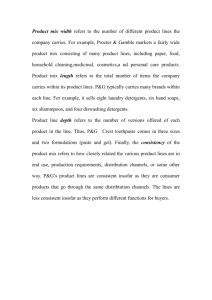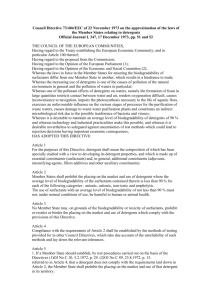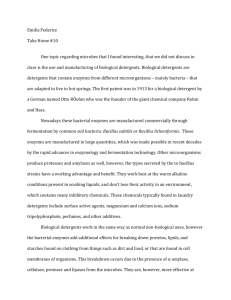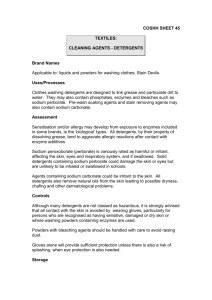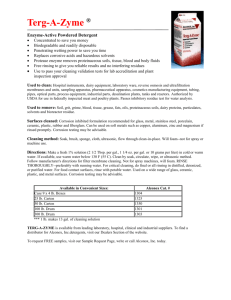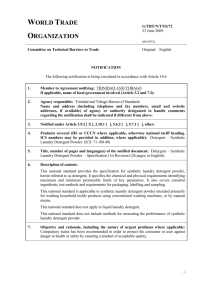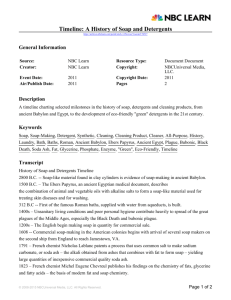PUBLIC WORKS TECHNICAL BULLETIN 200-1-47 30 AUGUST 2007 USE AT ARMY WASHRACKS
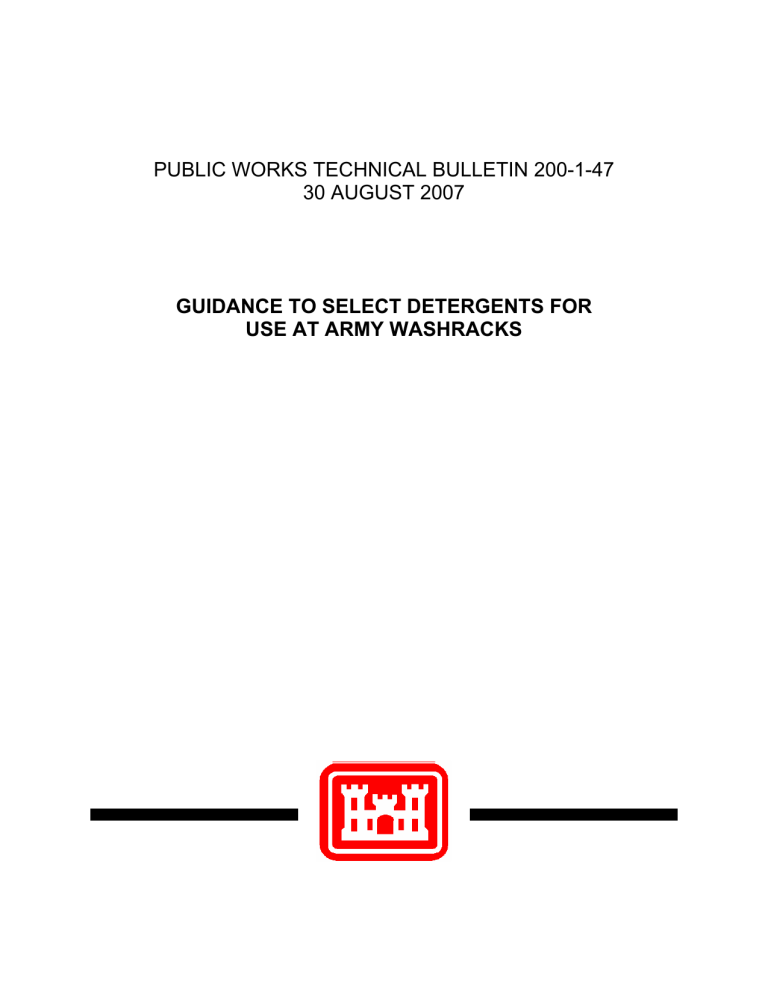
PUBLIC WORKS TECHNICAL BULLETIN 200-1-47
30 AUGUST 2007
GUIDANCE TO SELECT DETERGENTS FOR
USE AT ARMY WASHRACKS
Public Works Technical Bulletins are published by the U.S. Army Corps of Engineers, 441 G
Street NW, Washington, DC 20314-1000. They are intended to provide information on specific topics in areas of Facilities Engineering and
Public Works. They are not intended to establish new DA policy.
DEPARTMENT OF THE ARMY
U.S. Army Corps of Engineers
441 G Street, NW
Washington, DC 20314-1000
CECW-CE
Public Works Technical Bulletin
No. 200-1-47
30 August 2007
Facilities Engineering
Environmental
GUIDANCE TO SELECT DETERGENTS FOR USE AT
ARMY WASHRACKS
1.
Purpose.
a.
This Public Works Technical Bulletin (PWTB) transmits the results of a washrack detergent evaluation study sponsored by the Environmental Division of the Fort Benning, GA, Directorate of Public Works (DPW). The study determined the relative compatibility of several detergents with oil/water separators and biological wastewater treatment systems. This PWTB is intended for use by DPW environmental personnel when deciding which cleaning products will be allowed at washracks and maintenance cleaning facilities on an Army installation.
b.
All PWTBs are available electronically (in Adobe®
Acrobat® portable document format [PDF]) through the World Wide
Web (WWW) at the National Institute of Building Sciences’ Whole
Building Design Guide web page, which is accessible through URL: http://www.wbdg.org/ccb/browse_cat.php?o=31&c=215
2.
Applicability. This PWTB applies to all U.S. Army facilities engineering, public works, or environmental directorate activities.
3.
References.
a.
Army Regulation (AR) 420-49, "Utility Services," 28 April
1997.
PWTB 200-1-47
30 August 2007
b.
Technical Letter (TL) 1110-3-466, "Selection and Design of Oil/Water Separators at Army Facilities," 26 August 1994.
c.
Gerdes, G. L., et al., ERDC/CERL TR-00-04, “Designing
Coalescing Oil/Water Separators for Use at Army Washracks,”
December 2000.
d.
U.S. Army Environmental Center, “Joint Service Oil/Water
Separator Guidance Document,” SFIM-AEC-EQ-CR-200010, March 2001.
e.
AR 200-1, "Environmental Protection and Enhancement," 21
February 1997.
f.
PWTB 420-49-28, “Effect of Quick Release Detergent on
Oil/Water Separators”, 2 November 1999.
4.
Discussion.
a.
AR 420-49, Section 4-8, contains policy for wastewater treatment and surveillance as it pertains to oil/water separators. TL 1110-3-466, Sections 1.2.4 and 1.2.5, discuss cleaning agents and methods. AR 200-1 contains general pollution prevention policies. PWTB 420-49-28 discusses the evaluation of one “quick release” detergent at a Fort Lewis, WA,
Tactical Equipment Shop.
b.
Most detergents tend to cause stable emulsions of oil in water, thus rendering conventional oil/water separators useless.
Emulsified oil will pass through simple gravity or coalescing type gravity separators and flow into the receiving sanitary sewer (or, in some cases, a receiving stream). In locations where a separator discharges to a Publicly Owned Treatment Works
(POTW), emulsified oil in the separator effluent may violate pretreatment discharge limits placed on that separator.
Emulsified oil discharged to a POTW may cause the treatment works to be in violation of a National Pollutant Discharge
Elimination System (NPDES) permit. Because of the potential for
Notices of Violation, installation environmental offices have issued policy statements, memoranda, etc. that prohibit or limit the use of detergents at most Army ground vehicle washracks.
c.
Use of high-pressure hot-water washers is the recommended alternative to the use of detergents. However, high-pressure hot water often will not effectively clean components heavily soiled with oil and grease. Soldiers will circumvent the ban on detergents and purchase detergents locally in order to clean their tactical vehicles.
2
PWTB 200-1-47
30 August 2007
d.
Recognizing the need for cleaning products that are compatible with wastewater pretreatment systems, detergent manufacturers are now marketing detergents that form unstable emulsions. These detergents, sometimes called “quick release,”
“quick splitting,” or “separator friendly,” are said to allow oil to coalesce and separate from wash water after short periods of time. As long as the oil globules are able to rise to the surface of the water in an oil/water separator within the design detention time, then the separator will function properly. The
“quick release” detergent could be used without concern for regulatory violations.
e.
The study described in Appendix A is an evaluation of 20 detergents, many of which are “quick release” type detergents currently used at Army installations. Each detergent was tested for compatibility with oil/water separators, and with biological treatment systems. A simple gravity separation test was used to determine how much oil separated from a detergent-oil mixture within a 45 minute period (45 minutes being the minimal detention time allowed per oil/water separator design guidance).
Microtox toxicity tests were used to determine the relative toxicity of the detergents to microorganisms. The results of the tests are shown in Tables 2 thru 8 in Appendix A.
f.
As stated in Appendix A, the results of the laboratory testing should not be interpreted as an endorsement for use of any particular detergent. ERDC/CERL has not field-tested any of these products to verify laboratory findings, nor to determine cleaning effectiveness. The information is intended for use by
Army installation environmental personnel as guidance when selecting detergents to be used at washracks on a trial basis.
g.
One finding of note was that many of the detergents seemed to negatively affect the results of the oil and grease
(O&G) analysis by EPA Method 1664A. Components in the detergents appeared to cause the test results to be higher than the actual concentration of O&G.
5.
Points of Contact. HQUSACE is the proponent for this document. The POC at HQUSACE is Mr. Malcolm E. McLeod, CEMP-II,
202-761-0632, or e-mail: Malcolm.E.Mcleod@hq02.usace.army.mil.
Questions and/or comments regarding this subject should be directed to the technical POC:
U.S. Army Engineer Research and Development Center
Construction Engineering Research Laboratory
ATTN: CEERD-CN-E (Gary L. Gerdes)
3
PWTB 200-1-47
30 August 2007
Appendix A: Evaluation of Quick Release Detergents
Introduction
Background
Historically, detergents used to wash vehicles have caused the
Army’s gravity type oil/water separators to be ineffective.
These detergents form stable emulsions of oil in water that prevent the oil from floating to the surface. The emulsified oil passes through the separator and travels to the sewage treatment plant or other discharge point. This can create noncompliance with pretreatment or National Pollutant Discharge
Elimination System (NPDES) requirements regarding oil and grease
(O&G). Such emulsions can remain stable for long periods of time, unless some type of chemical treatment is used to break the emulsion. The use of chemical treatment at Army motorpool washracks is not practical due to operation and maintenance required. Thus, in an effort to maintain compliance with discharge requirements, the use of detergents has been banned at almost all Army washracks to prevent pass-through of oil. As an alternative, soldiers are encouraged to use hot water, high pressure washers.
Hot water washers are now in use at most motorpools. They are used to clean vehicles prior to inspection, or to wash components prior to repair work. These washers work well for light soiling, but when the surface to be cleaned is exceptionally greasy or oily, the level of cleanliness provided by the washers alone is usually not acceptable. A “Catch 22” had developed between the requirement to clean vehicles and the need to assure acceptable pretreatment of wash water, i.e., it was very difficult to achieve both. Water quality of separator discharges has a lower priority to soldiers because cleaning and maintaining tactical vehicles is linked to readiness, a very high priority. To adequately clean vehicles and parts, soldiers choose to ignore the detergent ban and purchase unauthorized soaps and detergents. It became clear to those responsible for
NPDES compliance that it is necessary to find an acceptable method of washing that will not interfere with separator performance.
A simple resolution of the conflict is the use of detergents that do not interfere with the performance of the oil/water separators. Many companies now make "quick release" or
A1
PWTB 200-1-47
30 August 2007
"separator friendly" detergents. These cleaning agents form unstable emulsions of oil and water — after a short time (10 minutes to 1 hour) the emulsion breaks and the oil is free to coalesce and rise to the water surface. In a small study sponsored by the former Army Center for Public Works, the
Construction Engineering Research Laboratory evaluated one of those detergents. BG-Clean 402 was selected (somewhat randomly) from a list of several detergents sold as being compatible with oil/water separators. That evaluation consisted of simple laboratory tests to verify the “quick release” characteristic of the detergent, and a demonstration of the detergent at an Army washrack to confirm compatibility with a typical Army oil/water separator. That study concluded that BG-Clean 402 did not interfere with the performance of the oil/water separator. A recommendation from that study was that additional detergents should also be tested.
In 2004, the Environmental Division at Fort Benning funded ERDC-
CERL to perform a more extensive study of “quick release” detergents. The objectives of this study were to verify the oil/water separator compatibility claims of several detergent vendors, and to determine the relative toxicity of those detergents on secondary treatments systems at sewage treatment plants. This PWTB discusses the results of that study.
Scope
The study was limited to an evaluation of 20 detergents. The detergents evaluated were selected from lists of detergents that were already authorized for use by specific Army installations.
Also selected for study were a few detergents that are commonly used on washracks or are readily available at chain retail stores, but are not sold as “quick-release” or “separator friendly.” It should be noted that many other detergents on the market today claim to be “separator friendly” or “quick-release” type cleaning agents, but not all of these detergents could be tested due to the limited resources of this study. The fact that a detergent was not included in this study does not preclude it from being acceptable for use at Army washracks.
Table 1 shows the detergents chosen for this study.
A2
PWTB 200-1-47
30 August 2007
Table 1. Detergents evaluated for Fort Benning study.
PRODUCT NAME
CBC 4 Citrus Grease Solv
VENDOR
American Cleaning Solutions
Clean All Purpose
Clean Split
Dawn
GSA
Certified Laboratories
Procter and Gamble
Duo Power Chemsearch
Envirogard-1 Hotsy
EnviroKlean Chemifax
Environ Landa
Gator Wash HD Product Services
Hurrisafe
Krud Kutter
Low Emuls Wash
MA 102
Power Cleaner 310L
Simple Green
Split Auto Scrub
Split Vehicle Wash
PCI of America
Supreme Chemical
Knight Marketing Corp.
JAD Chemical
Penetone Corp.
Sunshine Makers
Zep
Zep
The scope of this study was also limited to determining the compatibility of the detergents selected with pre-treatment oil/water separators, and with biological treatment systems at domestic sewage treatment plants. The detergents were not tested for corrosivity or for cleaning effectiveness — two characteristics that are valuable to the user when choosing a detergent to be used at an Army washrack.
Approach
Each of the 20 detergents was subjected to laboratory-scale testing to determine its oil separation characteristic relative to the other detergents tested. Simple oil separation tests were used to determine how quickly the oil/water emulsions created by the detergents would break and allow the oil to float to the surface. The premise is: the lower the concentration of
O&G is in the substrate of a settled detergent/oil/ water
A3
PWTB 200-1-47
30 August 2007 mixture, the more compatible that detergent is with oil/water separators.
Detergents that did well in the separation testing were then tested for relative toxicity using standard Microtox testing.
All would have been tested for toxicity had resources been available. Detergents were diluted with tap water per manufacturers’ guidance and then tested for toxicity. To determine the effect of chlorine in the tap water, some undiluted detergents were also tested for toxicity.
Test Procedures and Results
Quick-Release Characteristic
The quick-release characteristic of each cleaning agent was determined using a simple gravity separation test. A lubricant was mixed with water containing the cleaning agent and allowed to separate. The quick-release characteristic was determined by how much lubricant remained suspended in the mixture after a
45-minute period for separation. The steps for this test were as follows:
1.
The cleaning agent was diluted with tap water according to the manufacturer’s instruction on the packaging. If a range of dilutions were recommended (for example: 1:10 to 1:25), then a dilution near the middle of the range was used.
2.
A petroleum lubricant was added to the mixture so that the
Total Oil and Grease (O&G) concentration was 1000 parts per million (ppm). According to a previous ERDC/CERL characterization study (Gerdes 2000), this is a typical high
O&G concentration for wash water influent to Army oil/water separators. For each detergent dilution, three mixtures were made: one with motor oil added, one with hydraulic fluid added, and a third with lubricating grease added.
3.
The mixture was shaken in a separatory funnel for several seconds to create a homogeneous mixture, and to allow the detergent to emulsify the lubricant. The separatory funnels containing oil or hydraulic fluid were each upended six times to form a homogenous solution. The separatory funnels containing grease were shaken for 30 seconds, because the semi-solid grease was much more difficult to dissolve.
4.
The mixture was set aside for 45 minutes to allow the petroleum to coalesce and separate from the detergent
A4
PWTB 200-1-47
30 August 2007 solution. Current Department of Defense (DOD) guidance (SFIM-
AEC-EQ-CR-200010) recommends 45 minutes as the minimum detention time for gravity oil/water separators.
5.
Samples of the substrate (liquid below the floating layer of oil and grease) were then analyzed for O&G using U.S.
Environmental Protection Agency (EPA) Method 1664A. EPA
Method 1664A, while the preferred G&O analysis method, is somewhat inaccurate. Therefore, three samples were taking from each detergent-petroleum mixture, and the results were averaged. Table 2 shows the results of all analyses. EPA
Method 1664A measures the total amount of substance in a sample that is extractable by n-hexane — it does not identify specific petroleum products.
Interpretation of Quick-Release Results
The concentration of O&G in the substrate generally indicates the stability of the emulsion formed when mixing the sample.
For example, after 45 minutes of separation, the concentration of motor oil left in the Clean Split mixture was only 34 parts per million (ppm). The majority of the oil in the original 1000 ppm mixture had separated, coalesced, and floated to the surface of the separatory vessel. Ideally, this degree of separation will also occur in an oil/water separator.
The results shown in Tables 2 through 5 are only for comparing detergents with each other. The results do not necessarily show which detergents will or will not cause problems with oil/water separator performance. A period of trial usage at Army washracks is necessary to verify the compatibility of any detergent with pre-treatment. This study is intended to help in selecting detergents for further evaluation. Tables 2 through 5 can be used as a tool for predicting the probability of success.
It should again be noted that the detention time used for the laboratory-scale testing was only 45 minutes, the minimum time recommended by DOD guidance. Actual detention times in Army washrack separators are usually much longer than 45 minutes.
Most of the detergents tested for separation characteristic are good candidates for further testing at Army washracks.
For most of the detergents, the grease added to the detergent solution did not fully dissolve. Small bits of grease remained in suspension after the mixing period. Therefore, the separation tests involving grease did not accurately represent
A5
PWTB 200-1-47
30 August 2007 the quick release of emulsified grease, and data for the grease– detergent mixtures are not presented in this report.
Table 2. Concentration of O&G Remaining in the Detergent
Solution After 45 Minutes of Separation
(Original O&G concentration = 1000 ppm. All values in mg/L)
Motor Oil Hydraulic Fluid
Detergent
Clean 36 26 41 34 20 23 22 22
Clean All
Purpose
25 25 38 29 26 25 25 25
Environ
Zep Split
Vehicle Wash
36 24 23 28 33 23 36 31
26 25 M 26 28 29 28 28
32 32 64 43 59 40 35 45
Hurrisafe 100 43 86 76 54 38 62 51
Krud 40 47 55 47 140
Simple 110 160 140 137 49 38 36 41
Envirogard-1 120 100 150 123 68 60 76 68
Dawn
Low Emuls Wash 140 64 180 128 58 74 85 72
Zep Split Auto
Scrub
Enviroklean M 120 170 145 110 M 130 120
Power Cleaner
310L
150 180 150 160 150 180 250 193
CBC 4 Citrus
Grease Solv
Citrikleen
VPW SC 1000
820 240 750 600 150 90 200 147
1400 1200
M M
890 1160
2100 2100
210 M 810 510
110 890 1100 700
Note: M indicates missing data -- sample was lost during shipment.
A6
PWTB 200-1-47
30 August 2007
Substrate samples for the Citrikleen and VPW SC 1000 detergent mixtures had concentrations of O&G that were greater than 1000 ppm, i.e., greater than the original concentration of O&G. The source of that error could not be identified from the original data. Possible sources are: the samples were inadvertently contaminated with excess petroleum product; the original mixture was not thoroughly mixed (though care was taken to maintain good laboratory procedure), or laboratory error occurred during the analysis the procedure. But it was felt the most probable cause for the suspect results is that those two detergents, and perhaps others, contain constituents that interfere with the O&G test procedure.
As mentioned above, EPA Method 1664 is somewhat inaccurate as it does not specifically measure O&G. This is indicated by the long title of the procedure “Method 1664, Revision A: N-Hexane
Extractable Material (HEM; Oil and Grease) and Silica gel
Treated N-Hexane Extractable Material (SGT-HEM; Non-polar
Material) by Extraction and Gravimetry.” In effect, the reportable amount of O&G in a sample is defined by the test, and may not be the actual amount of O&G in the sample. Detergents may interfere with this procedure in two ways. First, if the oil is still emulsified, the emulsion will complicate the nhexane extraction and gravimetric measurement, and the procedure becomes very dependent on the laboratory analyst’s technique.
Second, the detergent may contain chemicals that are extracted by n-hexane and are included in the test results.
To further investigate, additional testing was performed on six detergents. The results of those tests were added to the results shown in Table 2, and are shown in Tables 3, 4, and 5.
Table 3 shows the results of testing on the detergent solution mixed with oil; the average of all tests (original and repeat testing); and the standard deviation of the test results. Table
4 is the same as Table 3, but shows the results for detergent solutions mixed with hydraulic fluid. Table 5 shows the results of O&G testing on only the detergent solutions.
Standard deviation is included in Tables 3 and 4 to show how the relative variability of the sample analysis results. The lower the standard deviation in the sample results, the more consistent the sample results are. The standard deviation calculations, along with the results shown in Table 5, seem to indicate that many detergents negatively impact the results of the O&G analysis procedure.
A7
PWTB 200-1-47
30 August 2007
The degree to which detergents affect O&G results varies, as seen in Table 5. It should be pointed out here that the original testing and re-testing were done by different independent laboratories. Comparing the results from the two laboratories in Tables 3, 4, and 5, it is evident that analyst technique had a significant effect on sample results.
Despite the apparently immeasurable impact that a detergent has on test results, some detergents still appear to be acceptable for use at washracks. If the analysis of a sample determines a low concentration of O&G, then there must have been minimal interference with the test procedure as well as a small amount of O&G. It is logical to assume that those detergents that showed good oil separation in Tables 2, 3, and 4 are likely to not significantly affect the O&G analysis results.
When selecting detergents for use on washracks, installation personnel should keep in mind that many detergents interfere with EPA Method 1664A. It is recommended that, prior to widespread installation use, laboratory testing be done on a diluted detergent to determine whether the detergent itself will impact O&G analysis results.
Table 3. Concentration of O&G Remaining in the Detergent
Solution After 45 Minutes of Separation
(Original O&G concentration = 1000 ppm. All values in mg/L)
Detergent
Motor Oil -
Original Test
Results
Motor Oil -
Repeat Test
Results
Avg
Standard
Deviation
Environ
Zep Split Auto
Scrub
Enviroklean M 120 170 681 789
Citrikleen 1400 1200 890 200 923 455.0
Note: M indicates missing data — sample was lost during shipment.
A8
PWTB 200-1-47
30 August 2007
Table 4. Concentration of O&G Remaining in the Detergent
Solution After 45 Minutes of Separation
(Original O&G concentration = 1000 ppm. All values in mg/L)
Detergent
Hydraulic Oil -
Original Test
Results
Hydraulic Oil -
Repeat Test
Results
Avg
Standard
Deviation
Environ
Zep Split Auto
Scrub
120 60 110 461 383 227 162.6
Enviroklean M 110 130 536 703 370 271.7
VPW-SC 110 890 1100
Note: M indicates missing data – sample was lost during shipment.
Citrikleen was not tested with hydraulic oil.
Table 5. Results of O&G Analysis of Detergent Solutions
(No Motor Oil or Hydraulic Oil Added)
Detergent
Test
Results
A B
Average
Standard
Deviation
Simple Green
Zep Split Auto
Scrub
71 79 75 4.0
413 413 N/A
Citrikleen 291
VPW-SC 1000 197 186 192 5.5
Toxicity Characteristic
A few detergents were chosen to be tested for toxicity.
Generally, the detergents that had the best oil separation results were selected for toxicity testing. (MA 102 and ZEP
Vehicle Wash were not tested due to insufficient quantities of those detergents.) Toxicity was determined using the trademarked Microtox testing procedure.
A9
PWTB 200-1-47
30 August 2007
The Microtox toxicity test consists of subjecting a particular group of microorganisms with successively more dilute aliquots of the sample being tested. The remaining viable microorganism population is recorded for each dilution of the original sample.
When reductions of viable microorganisms are at 20 and 50 percent, those dilutions are reported. Table 6 shows the results of the Microtox testing. The EC20 column shows the concentration (as a percentage of the original sample in the dilution) required to reduce the original population of microorganisms by 20 percent (i.e., a 20 percent kill off). The
EC50 column shows the concentration required to reduce the population of microorganisms by 50 percent. The EC50 concentration should normally be higher than the EC20 concentration. For example, the EC20 and EC50 for GSA Clean are
2.7% and 5.1%, respectively. That means that a solution of 2.7%
GSA Clean wash water and 97.3% distilled water will kill 20% of the test organisms. And a solution of 5.1% GSA Clean wash water and 94.9% distilled water will kill 50% of the test organisms.
Initially, the detergents were diluted according to manufacturers’ recommendations using tap water to create the samples for testing. The intent was to determine the toxicity of the wash water as it drained from a washrack. The diluted detergents were submitted for Microtox toxicity testing.
Because very low detergent concentrations were being recorded at
EC20 and EC50, it was suspected that the chlorinated tap water in the detergent samples may have contributed to the toxicity of the diluted detergents. (Dilutions made during the Microtox procedure are made with sterile de-ionized water.) To determine if this were the case, tap water and six undiluted detergents were then tested for toxicity. Table 7 shows the results of this second phase of toxicity testing, and Table 8 shows a comparison of results with and without dilution with tap water.
A10
PWTB 200-1-47
30 August 2007
Table 6. Results of toxicity testing on samples of diluted detergents.
Sample Dilution EC20 EC50
GSA Clean
Krud Kutter
1:10
1:20
2.7
1.1
5.1
1.6
ZEP Auto Scrub 1:32 0.88 1.8
Hurrisafe 1:10 0.48 0.90
Environ 1:20 0.46 1.3
Clean Split
Duo Power
1:10
1:10
0.12
0.057
0.42
0.10
Table 7. Results of toxicity testing on samples of undiluted detergents.
De-ionized Water
Tap Water
GSA Clean
Krud Kutter
>50
8.0
0.20
0.064
>50
18
0.35
0.084
Simple Green
Duo Power
0.035
0.0025
0.18
0.0080
Table 8. Comparing toxicity of diluted and undiluted samples.
Sample EC20 (%)
Undiluted
EC50 (%)
Diluted with tap water Undiluted
Diluted with tap water
GSA Clean
Krud Kutter
0.20
0.064
0.25
0.052
0.35
0.084
0.46
0.076
Duo Power 0.0025 0.0052 0.0080 0.0091
Values for “Diluted with tap water” are adjusted to include original dilution so all columns show dilution % of original full strength detergent.
A11
PWTB 200-1-47
30 August 2007
Interpretation of Toxicity Results
All detergents tested, as well as the tap water used to dilute them, were fairly toxic to the Microtox microorganisms. This is not surprising. Most detergents include a surfactant in their formulas. Surfactants are generally toxic to microorganisms because they alter the permeability of cell walls. Tap water contains small amounts of chlorine, which is intended to be toxic to microorganisms in water distribution systems. It appears from the data shown in Table 7 that the tap water did not significantly affect the toxicity of the diluted detergents.
This finding raises a legitimate concern regarding toxicity to biological treatment systems, however. The least toxic detergent tested was the GSA cleaner Clean All-Purpose Cleaner, which had an EC20 value of 0.20 percent (Table 7), which is equivalent to 2000 ppm. For a 2 million gallons per day (MGD) flow (1389 gallons per minute [gpm]), the amount of undiluted
Clean detergent in that flow would have to be 2.8 gpm to achieve the 0.2 percent concentration. That seems like a large amount of detergent, but that flow is possible for short periods of time during washing at the washracks. If the recommended detergent dilution (1:10) were used, then the wash water flow would have to be only 30.8 gpm. Potentially, this flow could occur if three or four motorpool washracks were using hot water washers at the same time.
There are reasons not to be concerned.
1.
It is likely that the microorganisms used for the Microtox test are more sensitive to detergents than the microorganisms growing in secondary treatment processes.
2.
Detergents in wash water are routinely discharged to sanitary sewers every day from households and commercial dischargers.
Microorganisms in sewage treatment facilities become acclimated to low levels of detergents, and even to slugs of wash water that enter the plant.
3.
The duration of the flows from hot water washers is relatively brief. The slug of wash water entering the sanitary sewer should become diluted during the several hours of travel to the sewage treatment plant.
Still, it is possible that the use of highly toxic detergents at washracks could adversely affect biological treatment processes.
The example given above for Clean is a best-case scenario. Duo
A12
PWTB 200-1-47
30 August 2007
Power, the most toxic detergent tested, is 50 to 100 times more toxic than Clean. Whenever a new detergent is introduced at an
Army installation such as Fort Benning, it is recommended that the number of users of that detergent be increased gradually to allow time for the receiving treatment works to acclimate.
Recommendations
1.
Army environmental personnel should use the information in
Tables 2 through 8 to select detergents for trial use at washracks. First select detergents that both allow good oil separation and have low toxicity.
2.
When selecting detergents for use on Army washracks, installation personnel should keep in mind that many detergents interfere with EPA Method 1664A. It is recommended that prior to widespread installation use, laboratory testing be done on a diluted detergent to determine whether that detergent will impact O&G analysis results.
3.
Whenever a new detergent is introduced at an Army installation such as Fort Benning, it is recommended that the number of users of that detergent be increased gradually to allow time for the receiving treatment works to acclimate.
A13
This publication may be reproduced
